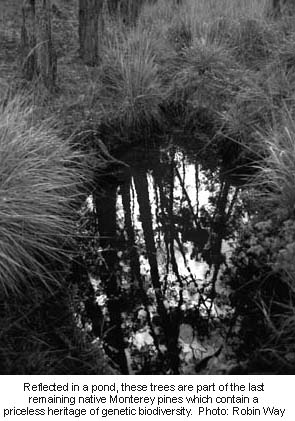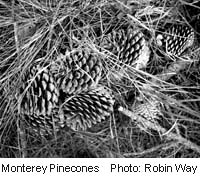Pebble Beach development imperils Monterey pines
 A
massive development in the Del Monte Forest proposes cutting down
more than 15,000 native Monterey pine trees to make way for a new
18-hole golf course, 160 new hotel rooms, 33 residential lots, a
golf driving range, 60 employee housing units and new roads and
trails. Proposed relocation of the equestrian facilities alone would
require cutting down over 1,000 Gowen cypress, coast live oak, and
Bishop pine trees. A
massive development in the Del Monte Forest proposes cutting down
more than 15,000 native Monterey pine trees to make way for a new
18-hole golf course, 160 new hotel rooms, 33 residential lots, a
golf driving range, 60 employee housing units and new roads and
trails. Proposed relocation of the equestrian facilities alone would
require cutting down over 1,000 Gowen cypress, coast live oak, and
Bishop pine trees.
The Pebble Beach Company released the Draft Environmental Impact
Report (DEIR) in February. The site of the project, the Del Monte
Forest, is the largest and most complex remaining stand of native
Monterey pines in the world.
The Ventana Chapter has submitted comments about our grave concerns
for the health of this rare ecosystem. Our biologists have determined
that the Draft EIR does not sufficiently address the impacts of
the proposed construction on the forest.
 Both
the assessment of the existing biological resources and the damage
that would be caused by the project are inaccurately portrayed.
No distinction is made among the different habitats on the site
and the genetic diversity of the plants. Incredibly, the complex
forest habitat is treated as though it were one large homogeneous
area-like a Christmas tree farm! Both
the assessment of the existing biological resources and the damage
that would be caused by the project are inaccurately portrayed.
No distinction is made among the different habitats on the site
and the genetic diversity of the plants. Incredibly, the complex
forest habitat is treated as though it were one large homogeneous
area-like a Christmas tree farm!
This DEIR was released amid growing public awareness of the fragility
and rarity of the Monterey pine forest which once covered about
19,000 acres in Monterey. Today, native stands of this species occur
in only five places in the world: Cedros (370 acres) and Guadalupe
Islands (200 trees only) off the coast of Baja in Mexico; and Aņo
Nuevo (1,000 to 1,500 acres), Cambria (3,000 acres) and the Monterey
Region, including Del Monte Forest (8,000 acres) along the California
Central Coast.
Arguably the Monterey pine forest is our most important native plant
community. Developers like to dismiss the Monterey pine forest as
too common to merit protection, but they fail to understand that
the few thousand remaining acres of functional native forest contain
a priceless heritage of genetic biodiversity that has enabled it
to survive over thousands of years of climate change and other environmental
stresses. This genetic library is likely to be essential in the
future to enable the multi-billion dollar timber and nursery industries,
where genetic variability has been bred out of the stock, to overcome
unpredictable future catastrophes. For a current example, the heavy
mortality early on from pine pitch canker has declined as more trees
have been shown to be resistant and others have the ability to recover
from the disease.
Although the exact number of remaining native Monterey pines varies
depending on the criteria used, there is agreement that between
40-50% of the original forest has been lost. In just the last 10
years, over 1,000 acres of the pine forest on the Monterey Peninsula
has been cut down to make way for development.
 This
dwindling of the resource is evidence that the Monterey pine forest
should be classified as Environmentally Sensitive Habitat Area (ESHA)
and fully protected under the Coastal Act. In a 2004 report, the
Natural Diversity Database program of the State Department of Fish
and Game calls Monterey pine forest "very threatened." This
dwindling of the resource is evidence that the Monterey pine forest
should be classified as Environmentally Sensitive Habitat Area (ESHA)
and fully protected under the Coastal Act. In a 2004 report, the
Natural Diversity Database program of the State Department of Fish
and Game calls Monterey pine forest "very threatened."
The proposed Pebble Beach project would continue to fragment this
fragile forest, degrading the remaining habitat. When habitat is
divided, the remaining smaller areas have a larger edge which is
subject to greater disturbance and is more vulnerable to degradation.
The smaller areas which the project designates as "conserved" were
not selected by biological criteria, but rather dictated by construction
needs. It is not clear whether these remnant pieces can support
target species in the long term.
The suggested mitigation for this project is woefully inadequate
and relies on unproven techniques. For example, the translocation
of federally listed species such as Yadon's piperia is highly risky.
Little is known about the habitat needs and propagation of this
endangered plant. The removal of thousands of trees and the bulldozing
of their habitat cannot be mitigated by planting seedlings. The
cumulative effects on ground water quality, raptors, and other wildlife
from the large quantities of herbicides, insecticides and rodent
poisons which would be used on the golf course and other landscaping
is inadequately addressed.
Even without the impacts of Pebble Beach development, the Monterey
pine forest is threatened by pitch canker which has caused significant
mortality of pines and continues to kill trees.
This project has a long way to go through the public review process.
We encourage you to follow and comment on this issue as it relates
to protection for all critical natural resources both in our local
community and statewide.
From an aesthetic and economic standpoint, the Monterey pine forest
provides the dark green backdrop that contrasts with the granitic
headlands and dramatic ocean vistas to make this area one of the
most attractive places in the world to live and visit. Let's not
kill the goose that lays the golden eggs!
< back to all issues
|

